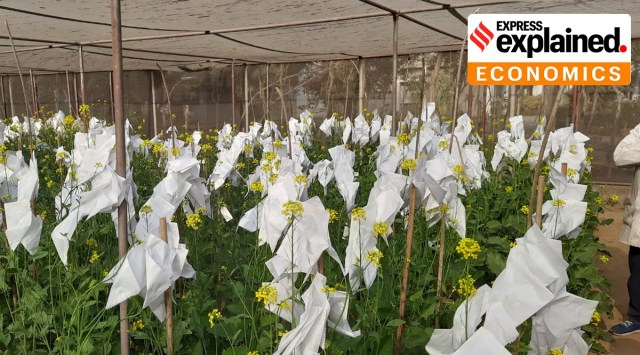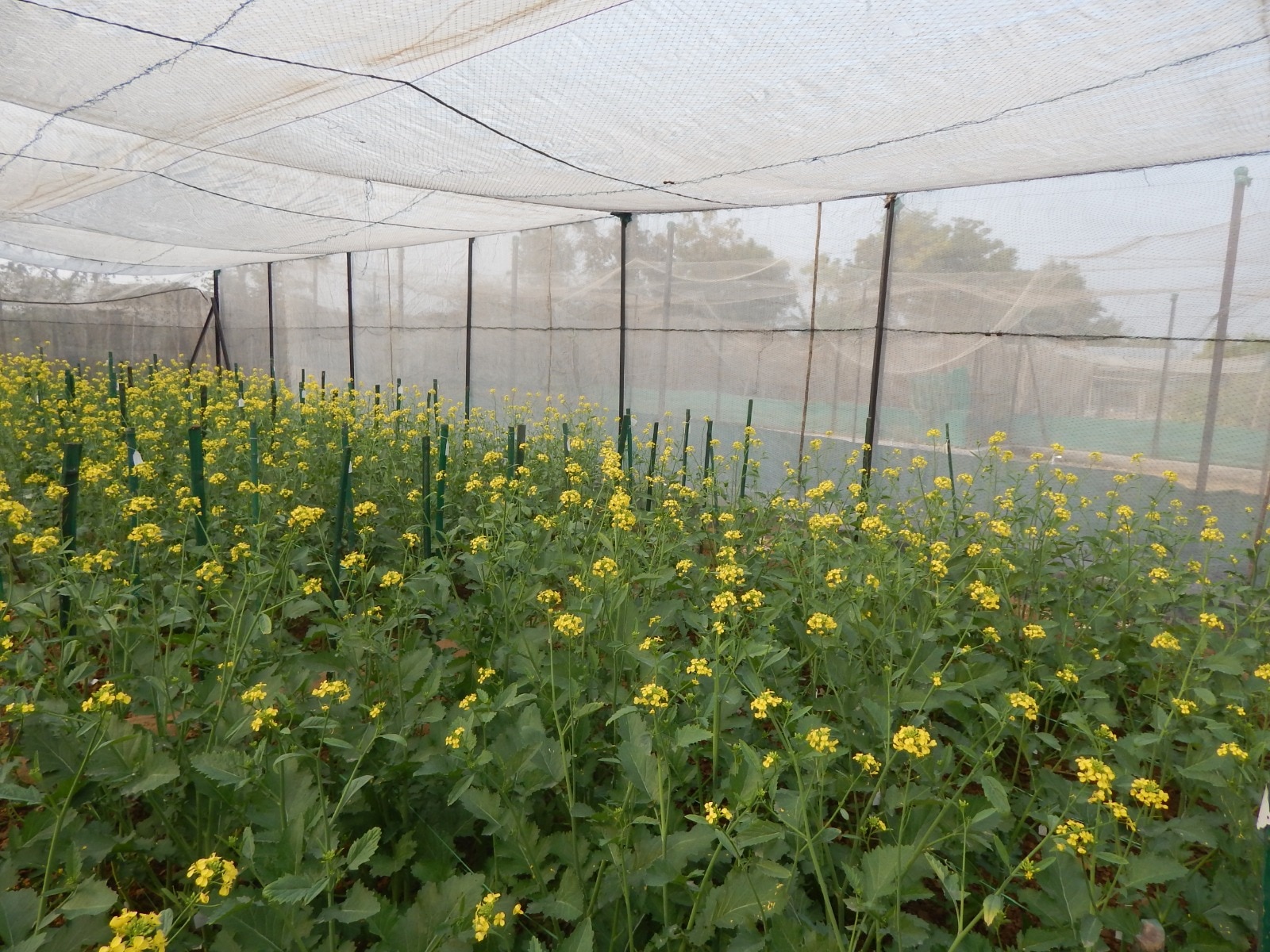Gene-edited mustard: Less pungent, more useful
Indian scientists have developed the first ever low-pungent mustard that is pest and disease-resistant. It is based on CRISPR/Cas9 gene editing, while being non-GM and transgene-free. Why does this hold significance for consumers and oilseed producers?
 The new genome-edited mustard plants being grown under protected net-house conditions. (Express Photo)
The new genome-edited mustard plants being grown under protected net-house conditions. (Express Photo) Oilseeds yield not only oil for cooking and frying. Their so-called meal – the residual cake after extraction of oil from the seeds – is a protein-rich ingredient used in livestock, poultry and aqua feed.
India’s most significant domestically-grown oilseed is rapeseed-mustard. Its share in the country’s production of vegetable oils has been estimated at 42.6% (more than soyabean’s 19.2%) and in that of meal at 30.3% (next to soyabean’s 38.9%), as per the US Department of Agriculture’s data for the marketing year ending September 2023.
Mustard seeds have high levels of glucosinolates, a group of sulphur and nitrogen-containing compounds contributing to the characteristic pungency of their oil and meal. While that limits the oil’s acceptability among consumers – especially those preferring cooking medium having less strong flavour and odour – the problem is even more with the meal. Rapeseed meal is unpalatable to poultry and pigs, while having to be mixed with fodder grass and water for giving to cattle and buffaloes. Besides reducing their feed intake, high glucosinolates are also known to cause goiter (swelling of neck) and internal organ abnormalities in livestock.
Breeding for Canola-quality mustard
A lot of effort in the past two decades – including by scientists at Delhi University’s Centre for Genetic Manipulation of Crop Plants (CGMCP) and the Indian Council of Agricultural Research – has gone into the breeding of rapeseed-mustard lines of so-called Canola quality.
 Naveen Chandra Bisht, senior scientist at the National Institute of Plant Genome Research (NIPGR). (Express photo)
Naveen Chandra Bisht, senior scientist at the National Institute of Plant Genome Research (NIPGR). (Express photo)
The dry seeds from the normal mustard (Brassica juncea) cultivated in India contain 120-130 parts per million (ppm or mg/kg) of glucosinolates. This is as against the sub-30 ppm levels in canola seeds. By lowering the glucosinolate content to the same dry seed weight concentration, the scientists have bred mustard lines whose oil and meal match the standard of canola-quality rapeseed (Brassica napus) in terms of pungency.

However, large-scale cultivation of these canola-quality low-glucosinolate mustard lines hasn’t taken place, a major reason being their vulnerability to pests and diseases. The same glucosinolates that limit the palatability of the meal and the exploitation of its true protein potential are also key arsenals of the Brassicaceae family crops – from mustard and canola to cabbage, cauliflower and broccoli – against invading pests, pathogens and termites.
“While the lowering of glucosinolate levels in seed is desirable for oil and meal, a concomitant reduction in the whole plant weakens its defence. The protection provided by glucosinolates to the plant should not be compromised,” said Naveen Chandra Bisht, senior scientist at the National Institute of Plant Genome Research (NIPGR) under the Department of Biotechnology (DBT).
 The new genome-edited mustard plants. (Express Photo)
The new genome-edited mustard plants. (Express Photo)
A Gene Editing breakthrough
That’s where the role of novel breeding research comes in.
Glucosinolates are synthesised in the leaves and pod walls of mustard plants. Their translocation and accumulation in the seeds happens through the action of glucosinolate transporter or GTR genes. There are 12 such genes under two distinct classes of GTR1 and GTR2 with six copies each.
What Bisht and fellow researchers have done is to “edit” 10 out of the 12 GTR genes in ‘Varuna’, a high-yielding Indian mustard variety. For this, they used CRISPR/Cas9 – a gene-editing tool deploying an enzyme, which acts as a “molecular scissors” to cut the DNA at precise targeted locations of the gene, and then letting the natural DNA repair process to take over.
“We used CRISPR/Cas9 editing to create mutations and change the nucleoide or basic building block sequence of the DNA in the 10 target GTR genes. By doing this, their encoded proteins, responsible for transport of the glucosinolates to the seeds, were rendered non-functional,” explained Bisht.
The seeds of the resultant targeted genes-edited Varuna mustard variety had glucosinolate content well below the 30 ppm canola-quality threshold. At the same time, the other plant parts, especially the leaves and pod walls enclosing the seeds, had significantly higher glucosinolate accumulation.
The GTR-edited low-seed high-leaf glucosinolate lines were tested for resistance against the virulent fungal pathogen Sclerotinia sclerotiorum and the insect pest Spodoptera litura. The edited lines displayed defence response against these at par with or better than that of the wild-type mustard. The higher glucosinolate concentration in the leaves and pod walls, due to their impaired transport to the seeds, clearly had a role.
The scientists at NIPGR, the lead lab, and CGMCP have published their research findings – the outcome of a DBT-funded project – in the high-impact Plant Biotechnology Journal.
GM versus GE
Bisht emphasised that the new GTR genes-edited mustard lines are transgene-free or non-genetically modified (GM). They contain no foreign genes like those of the Bacillus thuringiensis bacteria in cotton or Bar-Barnase-Barstar (isolated from other soil bacteria) in the GM hybrid mustard (DMH-11) bred by CGMCP scientists led by the former Delhi University vice chancellor Deepak Pental.
The low-seed high-leaf glucosinolate mustard lines developed by Bisht and other scientists are genome edited or GE, as opposed to GM or transgenic plants. While the Cas9 enzyme, derived from the Streptococcus pyogenes bacteria, was used to cut the DNA of the targeted genes in the first-generation plants, this protein is segregated out in the subsequent generations. The final GE lines contain no Cas9 protein and are transgene-free.
GM crops are currently subjected to stringent “environmental release” regulations in India, not just for commercial cultivation but even field trials and seed production. Such release is contingent upon clearance from a special Genetic Engineering Appraisal Committee (GEAC) under the Ministry of Environment, Forest and Climate Change (MoEFCC). The GEAC’s green signal is itself not binding on the Union Government, which gives the final nod.
On March 30, 2022, an office memorandum from the MoEFCC exempted GE plants “free of exogenous introduced DNA” from the requirement of GEAC approval for open field trials leading to commercial release. Such clearance is now necessary only at the level of an Institutional Bio-safety Committee (IBSC), comprising scientists from the institutions engaged in the GE crop development and from the DBT.
“We have prepared the document for submitting to the IBSC and are hopeful of conducting open field trials of the new GE mustard line in the coming rabi planting season (October-November),” Bisht told The Indian Express.
Why is this work important?
India is a huge importer of edible oils. These imports were valued at $20.84 billion (Rs 167,270 crore) during the fiscal year ended March 2023, while meeting over 60% of the country’s consumption requirement.
Given the massive foreign exchange outgo on account of imports, there is a dire need to boost domestic oilseeds production through focused breeding for improving crop yields, pest and disease resistance, and product quality.
Mustard and soyabean are India’s most widely-cultivated oilseed crops, planted annually on 9 million and 12.5 million hectares area respectively. Its higher average oil extractable content (38% versus 18% for soyabean) makes mustard the bigger “oilseed” crop, while a source of both fat for humans and protein for animals.
GM hybrid mustard and the new GE low-seed high-leaf glucosinolate lines are major plant breeding advancements – from Indian scientists – that can go some way towards bringing down the dependence on imported vegetable oils.
More Explained
Must Read
Buzzing Now


EXPRESS OPINION
May 18: Latest News
- 01
- 02
- 03
- 04
- 05































